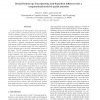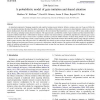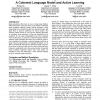512 search results - page 96 / 103 » Genetic algorithms for object recognition in a complex scene |
CVPR
2007
IEEE
14 years 10 months ago
2007
IEEE
A critical function in both machine vision and biological vision systems is attentional selection of scene regions worthy of further analysis by higher-level processes such as obj...
VRST
2006
ACM
14 years 2 months ago
2006
ACM
Some tasks vital to many mixed and augmented reality systems are either too time consuming or complex to be carried out whilst the system is active. 3D scene modelling and labelli...
NN
2006
Springer
13 years 8 months ago
2006
Springer
An important component of language acquisition and cognitive learning is gaze imitation. Infants as young as one year of age can follow the gaze of an adult to determine the objec...
EUSFLAT
2009
13 years 6 months ago
2009
One of the new trends in genetic fuzzy systems (GFS) is the use of evolutionary multiobjective optimization (EMO) algorithms. This is because EMO algorithms can easily handle two c...
MM
2004
ACM
14 years 2 months ago
2004
ACM
Image annotations allow users to access a large image database with textual queries. There have been several studies on automatic image annotation utilizing machine learning techn...



